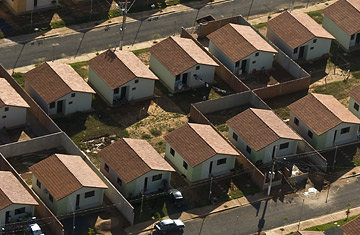
A single-family-home housing project in Campo Verde, Brazil
Luiz Antonio Gabriel has more than a few scary stories of his old life, when he lived in a two-room shack up a narrow alley on the outskirts of São Paulo. The worst part wasn't the floodwaters that swept over the mud floor whenever it rained, nor the bureaucratic purgatory of having no proper address. Gabriel's worst memories of his old life are the screams of his children wakened by rats scurrying over them.
Gabriel is grateful that those days are behind him. Along with the 200 families who had lived in a favela squeezed between rows of factories, he now lives with his wife and five kids in a small two-story home bordered by a forest. Built by local authorities in 2007, the house is small and basic, but Gabriel pays no rent — which is convenient because he is unemployed — and the scourges of sewage, rainwater and vermin are gone. (Read about business booming in Brazil's shanties)
"I could never hope to buy a house like this," Gabriel says as he cleans his front yard on recent steamy morning. "Life here is much better. Our biggest worry is that the kids will get bitten by the huge spiders from the woods over there."
Gabriel's contentment may be shared by many Brazilians over the next few years, thanks to a new government plan to reduce a housing deficit that disproportionately affects the country's poor. The Federal government last month announced it would provide $15 billion to finance the construction of 1 million more houses like the one given to Gabriel. And that's in addition to the $235 billion President Luiz Inacio Lula da Silva has pledged to spend on infrastructure in his second term of office that began in 2007, on projects ranging from roads and bridges to airports and sewage plants. Despite the global credit crunch, Lula has repeatedly vowed not to withhold even a penny of that proposed spending. Instead, he believes ambitious projects like the one he has called "My House, My Life" can keep the economy humming by making "the construction sector a springboard for job creation".
Municipalities are promising to hire local workers to build the new homes, spurring the local economy and creating a pool of semi-skilled tradesmen. The private sector is expected to invest as much as the government, making the housing program — according to Finance Minister Guido Mantega — add 2 percentage points to GDP growth.That's music to the ears of the local authorities in Guarulhos, the biggest of the 38 satellite cities that ring São Paulo. The city has built 5,000 houses similar to Gabriel's since 2001, and is in the process of adding a further 3,200. Funding usually comes from municipal and Federal coffers, foreign donors and development banks, but the guarantee of increased Federal money has been warmly welcomed by local politicians.
"Nobody wants to risk lending money and this program does away with that risk," the city's Housing Secretary Orlando Fantazzini says of the Federal money. "For Guarulhos it changes everything."
The new houses that line a small hillside on the edge of the city are hardly opulent. The interior is unfinished cinder block and the building work is often shoddy, with paint and plaster streaking the walls and fixtures and fittings haphazardly affixed. They are stuffy and cramped, and whole families must live in the boxy 485 square feet. Still, they are a huge step up from the shacks in which residents previously lived, and they go a long way to resolving Brazil's chronic shortage of low-income housing — the country's deficit of housing stock is estimated to be at least 7 million, the vast majority of it in the low-income bracket.
My House, My Life aims to provide 400,000 homes to the very poor, who will be expected to contribute — in a form yet to be decided — with 10% of their earnings over 10 years. The other 600,000 dwellings will go to the slightly better off and the lower middle class. Many will come with solar panels and all plan to use timber from approved sources to counter deforestation.
Despite the enthusiasm of recipients and local authorities, the housing plan still faces many questions. First and foremost, municipalities are required to find the land on which to build 1 million homes, and then to ensure that the sites are adequately serviced by transport links and basic infrastructure such as sewage and drainage, electricity and telephone lines and parks and recreation facilities.
Then, there's the quality of the construction work. In places such as Recife, where Lula moved slum dwellers to purpose-built new homes amid great fanfare, the new houses were poorly built, unfinished and badly located — and the new developments soon turned into the kind of favelas they were designed to replace.
"Companies need to do a good job and be responsible for the materials and the work," says Maria Lúcia Martins, a lecturer in urban planning at the University of São Paulo. "They have to be professional. In a country as vast as Brazil you may have great initiatives but all levels of government have to do their bit and the population has to keep an eye on them."
For now, though, the eyes of Gabriel and others like him are on their new homes. And already, many others are contacting local authorities looking for the same leg up. Mayors such Guarulhos' Sebastião Almeda knows he will struggle to contain the clamor. But that is tomorrow's problem. Right now, he is content to bask in the wave of appreciation.
"For those who know the reality of where people were living before, this is paradise," Almeida said as he toured a construction site last week. "These houses give people dignity."
